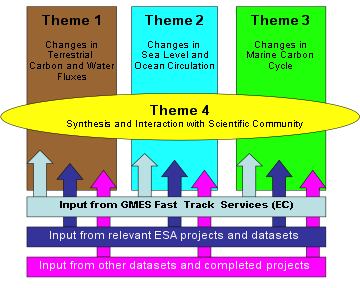Project structure
Climate change is arguably the greatest challenge facing mankind in the twenty-first century (IPCC, 2007). Climate change can only be understood through improved knowledge of the coupling between the dynamic processes in the atmosphere, the solid Earth, the hydrosphere, the cryosphere, the biosphere and the anthroposphere. These components are interlinked by forcing and feedback mechanisms that affect the other components. Long time series (~20-30 years) exist for many of these Essentil Climate variables (ECVs) at a spatial resolution of the order of 50-100 km. However their quality is often not adequately assessed and there are, for instance, inconsistencies in accuracies between sensors, data gaps and lack of proper merging of data from different sensors. MONARCH-A will occupy an extremely important niche in the current structure of Earth observations projects at high latitudes, and is organized along three major ECV themes;

MONARCH-A will be addressing ECVs related to;
(i) Changes in terrestrial carbon and water fluxes. High latitude regions are predicted to suffer much greater warming than lower latitudes as a result of climate change, and this will cause (and is causing) drastic changes in the carbon and water balance of the region, with associated large effects on snow cover, soil freeze-thaw periods, soil moisture, permafrost, growing season, land cover (including species changes), greenhouse gas fluxes and albedo. Of crucial concern are the feedbacks between these land surface processes and climate warming; this is recognised as one of the greatest sources of uncertainty in climate prediction (IPCC 2007).
(ii) Changes in sea level and ocean circulation. Lack of long in situ time series at adequate spatial and temporal coverage are challenging our knowledge of ocean changes in Arctic Ocean circulation, sea level and sea ice cover. As an example, the causes of ongoing or past major sea ice volume changes are not adequately known, nor do we know in detail the variability of the Arctic Ocean in the past or what causes a drift in the Arctic system observed now over several decades. In fact, several current estimates of the circulation in the high latitude and Arctic Ocean exhibit significant differences in their basic description of the flow field. Regarding sea level change in the high latitude and Arctic region, neither the mean nor the regional variations are accurately known.
(iii) Changes in marine carbon cycle are induced by a series of physical, chemical, and biological processes (gas exchange pump, biological pumps, ocean velocity field and hydrography) as well as human-produced CO2 emissions. Air-sea CO2 exchange is governed by the air-sea gradient in CO2 partial pressure, the gas transfer velocity, and ice cover. The sign and degree of a sea-ice carbon feedback are not yet conclusively clarified, as the pronounced seasonality and the extent of ice-free waters on shelf vs. deep waters can have counter intuitive effects (ACIA, 2004, chapter 9). Alterations in the near surface wind field as well as simultaneous changes in sea level, thermohaline structure, ocean circulation and primary productivity in the high latitude and Arctic regions will also change the CO2 partial pressure and uptake of CO2. Hence the vertical distribution of CO2 through convective circulation and the biological pump are subject to changes.


